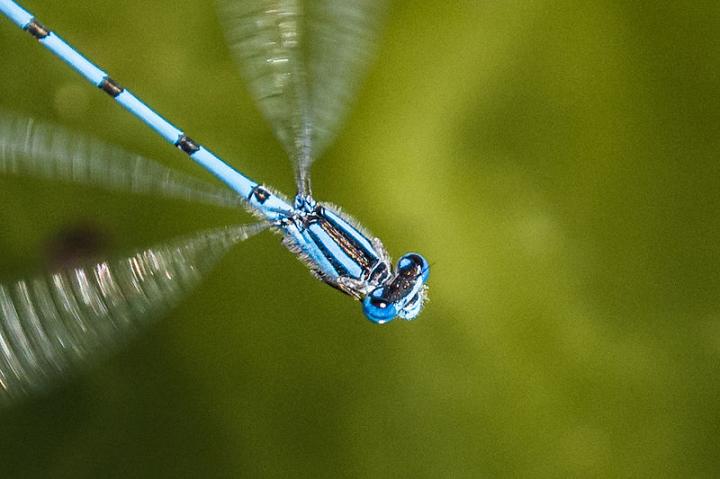Insects' fear limits boost from climate change, Dartmouth study shows

A new Dartmouth study shows for the first time that damselflies and other insects' fear of their predators, in addition to temperature, ultimately limits how fast they grow. Credit: Philip Cohen
“In other words, it's less about temperature and more about the overall environmental conditions that shape the growth, survival and distribution of insects.” says the study's lead author Lauren Culler, an Arctic postdoctoral researcher at Dartmouth.
The study appears in the journal Oecologia. A PDF is available on request.
Animals live in a constantly changing physical and biological environment, and the fear of being eaten can drastically alter their behavior, physiology, growth and population dynamics. That fear, known as the “flight-or-fight” response, can prompt physiological responses that stunt their growth and reproductive capability, either because they spend less time foraging for food and more time hiding or because they produce anti-predator defenses that can be energetically costly.
Previous studies have shown that warming temperatures make insects eat more and grow faster. The Dartmouth study looked at how fear, which typically lowers food consumption and growth rate, affects an insects' response to warming temperatures.
They brought damselflies into the lab and measured how much they ate and grew at different temperatures and how that changed when a fish predator was nearby. They used an experimental setup in which a damselfly was floated in a glass vial and exposed visually and chemically to a fish predator.
The results showed that in the absence of fear, the damselflies ate more food and grew faster as the temperature increased. Surprisingly, however, when a fish predator was looming, the damselflies ate about the same amount of food but grew much more slowly. The researchers aren't sure what happens to the food that doesn't go into growth, but they think it gets lost in the anti-predator response, possibly to production of stress proteins.
“Studies that aim to predict the consequences of climate change on insect populations should consider additional factors that may ultimately limit growth and survival, such as the risk of being eaten by a predator,” Culler says.
Postdoctoral researcher Lauren Culler is available to comment at leculler@gmail.com
Broadcast studios: Dartmouth has TV and radio studios available for interviews. For more information, visit: http://www.dartmouth.edu/~opa/radio-tv-studios/
Media Contact
All latest news from the category: Life Sciences and Chemistry
Articles and reports from the Life Sciences and chemistry area deal with applied and basic research into modern biology, chemistry and human medicine.
Valuable information can be found on a range of life sciences fields including bacteriology, biochemistry, bionics, bioinformatics, biophysics, biotechnology, genetics, geobotany, human biology, marine biology, microbiology, molecular biology, cellular biology, zoology, bioinorganic chemistry, microchemistry and environmental chemistry.
Newest articles

A universal framework for spatial biology
SpatialData is a freely accessible tool to unify and integrate data from different omics technologies accounting for spatial information, which can provide holistic insights into health and disease. Biological processes…

How complex biological processes arise
A $20 million grant from the U.S. National Science Foundation (NSF) will support the establishment and operation of the National Synthesis Center for Emergence in the Molecular and Cellular Sciences (NCEMS) at…

Airborne single-photon lidar system achieves high-resolution 3D imaging
Compact, low-power system opens doors for photon-efficient drone and satellite-based environmental monitoring and mapping. Researchers have developed a compact and lightweight single-photon airborne lidar system that can acquire high-resolution 3D…





















